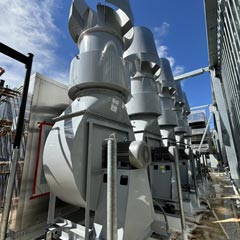Landlord and Tenant Services


Landlord and Tenant Services
Proactive real estate and lease management practices often require periodic assessments so that the owner or tenant can accurately determine the financial implications or risks related to deferred maintenance items, capital projects, recommended upgrades, or unrepaired deficiencies. We provide high-quality assessments to support these efforts. Our assessments are conducted by experienced professionals with a broad knowledge of building systems.



Our Services
In a commercial lease agreement, both property owners and tenants share responsibilities for maintaining the physical condition of a commercial asset. While lease agreements outline these responsibilities, identifying, understanding, and budgeting for them can become complicated and may require engineering or architectural expertise.

Tenant & Landlord Maintenance Obligation Review
Compare assessment findings to lease obligations for maintenance and repairs. Ensure tenant improvements and maintenance are aligned with lease provisions and Owner expectations.

Vacancy & Renewal Capital Expenditure Planning
A focus on the lease turn over requirements, capital needs of the building, renewal requirements, and maintenance and repair expenses that would be transferred to the Owner from the tenant at the conclusion or renewal of the lease.

Periodic Condition & Capital Expenditure Assessments
Periodic assessments to understand condition of asset. Typically done every 3-5 years for owned-assets or before/after major renovations or planned tenant improvement projects.
Tenant & Landlord Compliance Review Process
Lease Milestone or Condition Triggers Review
Upcoming lease, renewal, termination, or event that causes concern or requires analysis.
Lease Extraction or CAM Reconciliation
Identify and extract the maintenance provisions from leases, providing businesses and landlords with a comprehensive and streamlined view of their lease obligations.
Perform Assessment
Assessments conducted by experienced professionals with a broad knowledge of building systems.
Deferred Maintenance and Capex Analysis
Compare assessment findings to lease obligations for maintenance and repairs. Ensure tenant improvements and maintenance are aligned with lease provisions and Owner expectations.
Owner or Tenant Reclaims Value
Owner and tenant are prepared for capital planning events, renewal negotiations, or termination conditions & obligations.
Asset Types
Our experience extends to all asset types; this allows us to provide consistent and competent services for diversified portfolios.
Office & Health Care
PR&A has assessed and provided construction oversight for many of the office buildings that shape our nation’s skylines including high-rise towers, corporate campuses, life science and biomanufacturing facilities, medical office buildings, and hospitals.
Explore Office & Healthcare Property Services
Retail & Mixed-Use
Our team has significant experience with mixed use and retail properties across the country including regional malls, anchored retail centers, mixed-use developments, and adaptive reuse projects.
Explore Retail & Mixed Use Services
Industrial
Our experience spans over 50 million SF of industrial and warehouse space including mega distribution facilities, data centers, cold storage facilities, multi-story warehouses, shallow bay buildings, outdoor storage, trailer parking facilities, and master planned developments.
Explore Industrial Property Services
Community Centers, Schools, Museums, & Cultural Facilities
Facility or property condition assessments (PCAs) provide organizations with valuable insights into the state of their facilities and guide long-term capital planning. These assessments are particularly important when it comes to grant applications and capital planning initiatives.
Learn More
Asset Types
Our experience extends to all asset types; this allows us to provide consistent and competent services for diversified portfolios.

Office & Health Care
PR&A has assessed and provided construction oversight for many of the office buildings that shape our nation’s skylines including high-rise towers, corporate campuses, life science and biomanufacturing facilities, medical office buildings, and hospitals.

Retail & Mixed-Use
Our team has significant experience with mixed use and retail properties across the country including regional malls, anchored retail centers, mixed-use developments, and adaptive reuse projects.

Industrial
Our experience spans over 50 million SF of industrial and warehouse space including mega distribution facilities, data centers, cold storage facilities, multi-story warehouses, shallow bay buildings, outdoor storage, trailer parking facilities, and master planned developments.

Community Centers, Schools, Museums, & Cultural Facilities
Facility or property condition assessments (PCAs) provide organizations with valuable insights into the state of their facilities and guide long-term capital planning. These assessments are particularly important when it comes to grant applications and capital planning initiatives.
Nationwide Services
Our office headquarters are centrally located in Dallas, Texas with regional offices in Texas, Florida, Illinois, Georgia, Colorado, Tennessee, Minnesota and New York. We have completed projects in nearly all U.S. metropolitan cities and states.
Explore Representative Markets
Request an Assessment
Discover the Impact of Our Work
Browse Our Website to Understand How Our Expertise Translates into Successful Outcomes for Our Clients.
Explore Now

Discover the Impact of Our Work
Browse Our Website to Understand How Our Expertise Translates into Successful Outcomes for Our Clients.
Explore Now